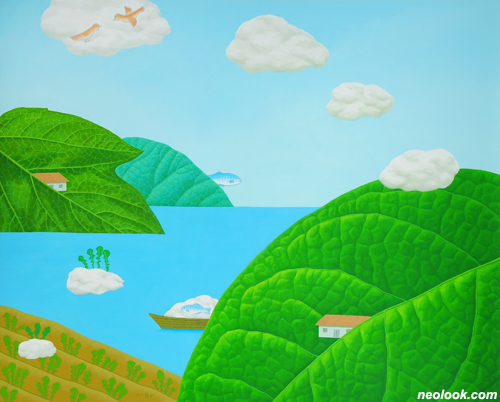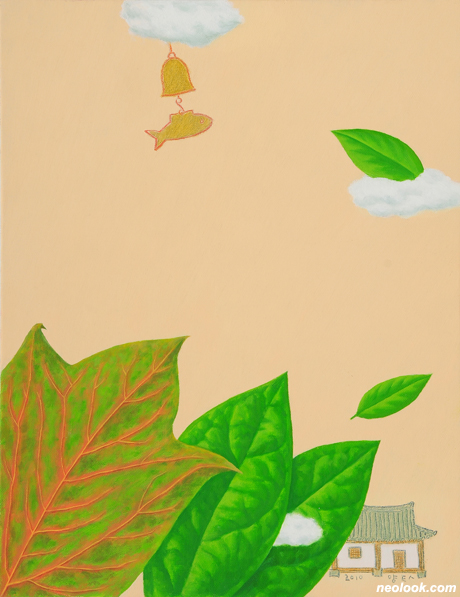- ● homepage
- ● archives
- ● restoration
- ● books
- ● big banners
- ● post board
- ■ neo's search
- ■ about us
- ■ 게재방법 안내
- 개인정보처리방침

- [email protected]
- Tel. 02_335_7922
- Fax. 02_335_7929
- 10:00am~04:30pm
- 월요일~금요일
- 3/3(월) 대체공휴일

구름따라 잎새처럼 Following the clouds like leaves
양태숙展 / YANGTAESOOK / 楊泰淑 / painting 2010_0716 ▶ 2010_0806
● 위 이미지를 클릭하면 양태숙 블로그로 갑니다.
별도의 초대일시가 없습니다.
관람시간 / 10:00am~06:00pm
KSD 문화갤러리 KSD CULTURE GALLERY 서울 영등포구 여의나루로 4길 23 한국예탁결제원 1층 Tel. +82.31.900.7449 gallery.ksd.or.kr
자유와 희망을 담은 자아(自我)로서의 잎사귀 1. 나뭇잎과 구름의 대화 ● 화가의 상상력에 무한한 영감을 불어넣어 주는 중요한 요소 가운데 하나는 화가가 온 몸으로 경험하는 환경일 것이다. 에드가 알렌 포우(Edgar Allen Poe)의 단편들에서와 같이 오래된 이끼가 뒤덮인 고풍스러운 낡은 집이 영감의 실질적인 원천이었던 것처럼, 집과 같은 공간을 통해 미묘하게 구축해 나가는 시적 명상들은 작가 양태숙의 작품을 일구어내는 중요한 요인이다. 깊고 높은 하늘과 검고 짙은 밤, 생명으로 가득 찬 나무들로 빼곡히 둘러싸인 작가의 작업실은 인적 드문 없는 산속에 위치한다. 자신에게 말을 걸어왔던 나무와 새들을 소담하게 그려내며 물아일체(物我一體)의 장자(莊子)적 사유를 관조하는 작가는 "나뭇잎과 구름"이라는 설레는 랑데부를 시도하고 있다. 하늘에 목을 내민 나무로 세상을 비유한 작은 모티브가 소담하게 어우러진 그의 조형세계는 늘 그렇게 푸르른 잎사귀와 꿈으로 부풀어 오른 구름의 이야기로 전개된다. 자연을 집안 내부로 끌어들여 구름이 식사가 되고 나뭇잎이 다정한 친구가 된다. 하늘을 나는 물고기나 강속을 헤엄치는 구름, 산이 되어 나무를 길러내는 잎사귀, 이들은 모두 역발상적인 사고와 인식의 자유로운 해체 또는 융합, 사물의 고정관념을 뛰어넘은 발상의 전환을 보여준다. 범우주적인 나무의 본성에 대한 그리움에 천착한 작가가 나무의 변신체인 잎으로의 전환은 필연적인 귀착점으로 보인다. 나뭇잎을 통해 작가는 더 많은 사유의 자유로움을 획득하였을 것이며, 또한 끊임없이 자신의 모습을 반영하며 생각하는 나뭇잎으로의 자신의 모습을 그려나갈 것이다. 전작에 비해 한층 더 일상적인 기물들을 화면에 끌어들임으로써 현실과 환상, 실재와 허구, 지각과 사유, 대상과 공간, 질서와 혼돈이 상큼하고 경쾌하게 결합되어 곳곳에 작가의 빛나는 감성이 녹아있는 화면들로 연출된다. 그리고 그 삶의 모습도 자아의 존재감을 즐거운 상상력으로 풀어내고 있다.

- 양태숙_연못_캔버스에 유채_65.1×90.9cm_2010

- 양태숙_강_캔버스에 유채_130.3×162.2cm_2010
2. 나뭇잎=구름=나 ● 잎으로 섬세하게 퍼져있는 잎맥은 작가의 핏줄, 숨결, 숨소리로 우주의 거대하거나 또는 미세한 생명의 소리를 듣는 정신과 같다. 눈과 귀를 열고 나뭇잎은 세계를 바라보며 소통한다. 시원한 한 줄기의 바람이 물결의 파동으로 배를 띄운다. 하늘 위를 떠다니는 쪽배엔 잎은 사공이 되고 구름은 객이 된다. 이것은 전작(前作)에서 나무가 작가의 대체물로 거시적인 세계에 관한 이입의 단계였다면 근작들은 미시적인 세계를 적극적으로 체험하고 있으며, 일상적인 삶으로의 소소함에 즐거움을 느끼며 자연합일들은然合一) 안에서 느끼는 안빈낙도(安貧樂道)의 정신적 승화의 확장과 구체성을 제시하고 있다. 이는 작가가 자연과 함께 호흡하며 자연에 순응하고, 대자연의 생명성을 더불어 체험하고 있는 것이다. 범우주적인 세계의 유한한 존재로써의 작가 자신의 위치를 겸허히 인정하는 생의 따뜻한 시선이 화면 곳곳에 묻어나고 있다. ● 나뭇잎과 구름은 둘 다 하늘을 날 수 있다라는 도상학(iconography)적인 성질을 지니고 있다. 물론 나뭇잎은 고유한 형태를 간직한 유형의 물질이지만 구름은 기의 덩어리인 비물질로써, 수증기가 변화무쌍하게 자신의 존재를 변환시킨 변형태이다. 즉, 구름 그 자체는 우주의 신비한 에너지의 흐름을 증명하는 존재인 것이다. 바람은 구름을 일으키며 구름은 나뭇잎(작가의 자아)을 태우고 먼 시간으로의 떠남과 만남을 보여준다. 그렇다면 구름은 작가의 또 다른 자아로 볼 수 있다. 작가는 나뭇잎으로 구름으로 형상을 변화해 나가면서 자유를 위한 갈망의 의지를 끊임없이 이입시키고 있는 것이다. "나뭇잎과 구름 그리고 나"는 작가의 숨길 수 없는 들켜버린 강력한 자유에로의 욕구의 표출인 것이다. ● 사실 나무와 나뭇잎의 관계는 체용설(體用說)로써 이해할 수 있다. 체는 움직이지 않는 고유의 본성적 존재라면 용은 그 본성을 활성화시키고 그 의지를 전달하는 도구적 존재라 할 것이다. 나무가 견고히 대지를 박차고 자라나 태양과 교합하고 나무의 뜻을 품은 잎사귀는 ● 하늘을 여행하는 것이다. "나무의 언어를 갖고 잎사귀가 구름에게 달려 간다"라는 작가의 말처럼 그들은 그렇게 굳센 의지를 품고 영원한 자유에로의 만남을 꿈꾸는 것이다.

- 양태숙_편지_캔버스에 유채_45.5×53cm_2010

- 양태숙_집_캔버스에 유채_60.6×72.7cm_2010
3. 푸른 잎사귀는 강한 희망의 상징 ● 양태숙의 화면에 있어서 형태가 명징한 조형은 분명 민화의 조형적 법칙에 근거를 두고 있음이다. 단순함으로 오는 서술의 명확함과 환기성은 의미전달이 명료하며 강력한 감정적 파장을 이끌어 낸다. 진 쿠퍼에 의하면 "푸른 나뭇잎은 강한 희망에의 상징"이라 하듯이 작가는 자아로 대별되는 나뭇잎을 그려냄으로써 싹이 돋고 꽃을 피우는 나무의 굽히지 않는 희망을 구체화시킨 것이다. 이는 작가 자신의 갈망하는 미래의 긍정과 푸른빛 희망인지도 모르겠다. ● 작가 양태숙의 작품세계는 밀도 높은 감성과 서정성을 보인다. 이는 조용히 작업에 몰두하는 작가에게 길러진 특유의 정서라 할 수 있다. 작가의 조형에 있어서 미술사적 시작이 초현실주의로써, 현실을 또 하나의 환상으로 풀어내는 지극히 마그리트적인 내용에서 시작되고는 있지만, 소재의 선택과 내용은 동양적인 자연관과 그 자연을 존중하고 더불어 살아가고자 하는 전통성을 견지하고 있다. 그의 화면을 대하노라면 관자의 마음은 잎이 숨쉬는 화면으로 끌려 들어가 형체가 없이 녹아버리고, 화면과 내가 하나가 되어 바다가 된 하늘을 유유히 노닌다. 이것이 양태숙 작품이 가진 힘인 것이다. 사막에서 만나는 한 모금의 맑은 물과 검은 밤의 별처럼. 이는 격정적 감정의 표출을 절제하여 일체의 긴장도 감정의 기복도 없이, 작가 심연에 숨겨둔 심상(心象)을 담담히 건져내고 있기 때문인 것이다. ■ 박옥생

- 양태숙_풍경소리_캔버스에 유채_41×31.8cm_2010

- 양태숙_차 한잔_캔버스에 유채_41×31.8cm_2010
Leaves as Self Encapsulating Freedom and Hope 1. Conversation between leaves and clouds ● One of the critical elements inspiring an artist's imagination is the environment the artist experiences through his or her whole body. In a short story by Edgar Allen Poe, an archaic, mossy house was the spring of his inspiration. Likewise, Yang Tae-sook's art is filled with poetic subtlety represented through space like a home. Her studio is nestled in desolate mountains surrounded by trees. Depicting trees and birds speaking to her in a simple manner, and contemplating oneness between objects and self, (as Zhuangzi did), Yang presents rendezvous between leaves and clouds at night under a profound sky. ● Yang likens the world to a tree soaring toward the sky. This motif develops into a story of ever-green leaves and dreamy clouds. The clouds become her food, and the leaves become her friends. Flying fish, swimming clouds, and leaves nurturing trees all imply change in ways of thinking, melding our perceptions, surpassing our fixed notions. It seems inevitable for Yang to focus on leaves, as she has always longed for trees as part of the universe. Acquiring freedom of thought through leaves, she depicts herself as a thinking leaf. She presents scenes imbued with her brilliant sensibility, drawing on everyday items, combining reality and illusion, reality and fiction, perception and thought, object and space, order and chaos, in a fresh, light-hearted manner. She also represents the presence of her self with delightful imagination. 2. Leaf=cloud=I ● A leaf vein spreading delicately is a metaphor for her blood vessel, the sound of her breath, and the sound of the minute and enormous life forms of the universe. The leaf communicates with the world, opening its eyes and ears. A fresh breeze raises nipples, making her boat float. In a tiny boat floating through the sky a leaf is a boatman, and clouds are passengers. In her previous work a tree represented the artist, and signified a macroscopic world, while her recent work delights in the trivial, microscopic world. Yang presents the state where she becomes one with nature, being content in poverty, taking pleasure in being honest. She breathes with, and adapts herself to nature, and experiences its vitality. In her work Yang admits her position as a finite being in the universe. Her warmhearted gaze toward life is sensed everywhere in her work. ● The leaves and clouds of her work share the same iconographic quality in that the two can fly the sky. The leaf is material, with a concrete and inherent form, while the cloud is a more like a mass of energy; an ever-changing shape transforming vapor. The cloud is substance proving the flow of energy in the universe. The wind brings the cloud and the cloud carries the leaf, making a journey into time. The cloud is thus another of the artist's selves. The artist brings her craving for freedom in her work through many metamorphoses of leaves and clouds. Leaf, Cloud, and I is her strong will for liberation. ● It can be said that the relationship between tree and leaf is associated with Cheyong-seol (體用說, or the theory of nature and operation. While 'che'(體) refers to the unmoving, unchanging original nature, 'yong' (用) means a means animating the nature and conveying its will. A tree grows from the earth and becomes united with the sun, and leaves bearing the tree's will travels the sky. As the artist states that "Leaves rush to the clouds in the language of trees.", they dream of an encounter for eternal freedom with their strong will. 3. Green Leaf, a Symbol for Hope ● Yang's clear forms have roots in the formative rules of folk painting. Her work's clear narrative and evocative quality, from simple form, conveys a definite message, and raises strong emotion. As Jin Cooper clarified "Green leaves are a strong symbol for hope.", The artist concretizes this idea by painting leaves of unyielding hope and trees that bloom even in hardship. The leaves affirm the future and present a green hope. ● Yang's art world consists of high density sensibility and lyricism. Her distinctive emotion has been nurtured working in a serene atmosphere. Although her work begins in surrealism, like Magritte depicting reality through illusion, Yang maintains this through the Oriental tradition of respecting nature. Viewing her work can make your mind melt into the leaves breath, becoming one with it, wandering through the sky. The force of her work is in this. Like clear water in a desert, and stars at night, Yang's work features her mental imagery hidden in her self, without tension or emotional undulation to manifest intense feelings. ■ Park Ok-saeng
Vol.20100716f | 양태숙展 / YANGTAESOOK / 楊泰淑 / painting

